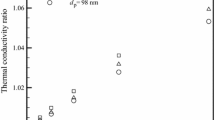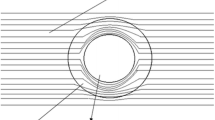Abstract
Thermal conductivity enhancement of nanofluids is very attractive to thermal and heat transfer engineering, however its mechanism is not clear yet. In this study, it is proposed that the surface charge state of nanoparticles is to explain the thermal conductivity enhancement of nanofluids. By comparing to the previous reported results, it is shown that the interparticle interaction due to the surface charge state is the most important factor to increase of thermal conductivity of nanofluids.





Similar content being viewed by others
Abbreviations
- A:
-
Coulomb constant (9.0 × 109 N m2 C−2)
- \( \hat{c}_{v} \) :
-
Specific heat (J K−1)
- e:
-
Fundamental charge of an electron (1.6021765 × 10−19 C)
- k:
-
Thermal conductivity (W/m−1 K−1)
- k b :
-
Boltzmann constant (1.3807 × 10−23 J K−1)
- l :
-
Mean free path of molecules or nanoparticles (m)
- m :
-
Mass (kg)
- n :
-
Particle concentration (m−3)
- n i :
-
Concentration of the ionic species i
- q :
-
Electric charge (C)
- r :
-
Particle radius (m)
- T :
-
Absolute temperature (K)
- z i :
-
Valence of ion
- ɛ 0 :
-
Permittivity of vacuum (8.8542 × 10−12 F m−1)
- ɛ bf :
-
Dielectric constant of medium
- ζ :
-
Zeta potential (mV)
- κ :
-
Debye–Huckel parameter (m−1)
- φ :
-
Volume fraction of nanoparticle
- Br :
-
Brownian motion
- EDL :
-
Electrical double layer
- eff :
-
Effective
- bf :
-
Base fluid
- Mw :
-
Maxwell
- np :
-
Nanoparticle
References
Choi SUS (1995) Enhancing thermal conductivity of fluids with nanoparticles. ASME FED 231/MD 66:99–105
Maxwell JC (1873) A treatise on electricity and magnetism. Clarendon Press, Oxford
Kumar DH, Patel HE, Kumar VRR, Sundararajan T, Pradeep T, Das SK (2004) Model for heat conduction in nanofluids. Phys Rev Lett 93:144301
Jang SP, Choi SUS (2004) Role of Brownian motion in the enhanced thermal conductivity of nanofluids. Appl Phys Lett 84:4316–4318
Chon CH, Kihm KD, Lee SP, Choi SUS (2005) Empirical correlation finding the role of temperature and particle size for nanofluid (Al2O3) thermal conductivity enhancement. Appl Phys Lett 87:153107
Lee D, Kim JW, Kim BG (2006) A new parameter to control heat transport in nanofluids: surface charge state of the particle in suspension. J Phys Chem B 110:4323–4328
Lee D (2007) Thermophysical properties of interfacial layer in nanofluids. Langmuir 23:6011–6018
Milanova D, Kumar R (2005) Role of ions in pool boiling heat transfer of pure and silica nanofluids. Appl Phys Lett 87:244107
Jung JY, Yoo JY (2009) Thermal conductivity enhancement of nanofluids in conjunction with electrical double layer (EDL). Int J Heat Mass Transf 52:525–528
Hunter RJ (1987) Foundations of colloid science, 1st edn. Clarendon Press, Oxford
Ohshima H, Furusawa K (1998) Electrical phenomena at interfaces; fundamentals, measurements, and applications, 2nd edn. Marcel Dekker Inc, New York
Chon CH, Kihm KD (2005) Thermal conductivity enhancement of nanofluids by Brownian motion. J Heat Transf 127:810
Li D (2004) Electrokinetics in Microfluidics. Elsevier, London
Wen DS, Ding YL (2004) Experimental investigation into convective heat transfer of nanofluids at the entrance region under laminar flow conditions. Int J Heat Mass Transf 47:5181–5188
Koo J, Kleinstreuer C (2004) A new thermal conductivity model for nanofluids. J Nanopart Res 6:577–588
Prasher R, Bhattacharya P, Phelan PE (2005) Thermal conductivity of nanoscale colloidal solutions (nanofluids). Phys Rev Lett 94:025901
Acknowledgments
This work was supported by the grants from Korean Sciences and Engineering Foundation under Contract R01-2008-000-20458-0. Also this work was supported by a grant from Kyung Hee University in 2010 (KHU-20100186).
Author information
Authors and Affiliations
Corresponding author
Rights and permissions
About this article
Cite this article
Jung, JY., Kang, Y.T. Effect of surface charge state on the thermal conductivity of nanofluids. Heat Mass Transfer 48, 713–718 (2012). https://doi.org/10.1007/s00231-011-0921-6
Received:
Accepted:
Published:
Issue Date:
DOI: https://doi.org/10.1007/s00231-011-0921-6




